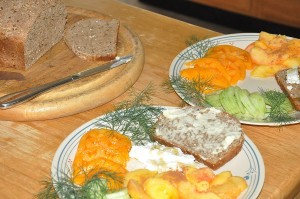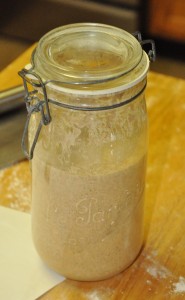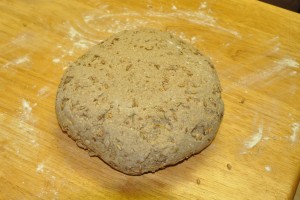I did it.
I baked a bread that was almost like the bread Danute served with breakfast at the Nemunas Tour guesthouse in Kaunas, Lithuania: dense, sweet, nutty with seeds and whole grains, crunchy of crust.
I have pined for good Lithuanian bread from the day we got home in May, 2012. Okay, I have always had a thing for great, weighty, grainy loaves, but Danute’s bread was something else. I searched cookbooks and Internet, and finally found a recipe that seemed authentic, but it wasn’t really what I wanted. The bread, however, was exactly what it claimed to be: “Lithuanian sourdough rye bread.” It just wasn’t Danute’s chewy bread, dark and tangy, and full of texture.
Ultimately I went back to the source, and sent her an email pleading for the recipe. A Christmas card brought good wishes, the hope that we would return someday to visit, and a link to a recipe for “Multi-Grain Bread.”
A link to a Lithuanian website. Translating Lithuanian is a problem, even with the convenience of the Google Translate gadget. Still I worked through the instructions phrase by phrase, ordered up a pile of stuff from Bob’s Red Mill, and waited until I had nerve enough to tackle the job.
(By the way, I was meticulous in measuring ingredients and following directions. Oh, and the rye flour, whole grains and seeds came from Bob’s Red Mill. If you can’t find them in your local grocery store, you can always order them online.)
Step one: read the recipe carefully and make sure supplies are adequate and timing has been worked out. My Dear One had to run out and replenish rye flour; it looked like a twenty-four hour project.
Step two: wake up the sourdough starter.
The starter? I had created that back when I made the Lithuanian sourdough rye bread and a jar of it has been sitting in the refrigerator for months. I took a glop’s worth—three-quarters of a cup?—out of the jar and “fed” what remained. That glop went into a bowl that I covered with plastic and left to warm in the oven under the heat of the lightbulb. By the time I needed it, about four hours later, it was all bubbly and pungent.
Sourdough starter (from the recipe for “Lithuanian Sourdough Rye Bread)
Day 1: Mix 100 g of rye flour with 150 ml of warm water (about 98.6° F) and pour into a glass bowl or an empty glass jar. Cover with a clean damp cloth and place somewhere warm, like an oven heated to about 77°F. Steady warmth is important.
Day 2: The sourdough should have started to ferment, slight bubbling and increase in mass. Mix in 100 g of rye flour and 100 ml of tepid water. Water should not be too hot or it may “kill” your sourdough. Cover with damp towel and set in a warm place for another 24 hours.
Day 3: Take out 3-4 tablespoons of the sourdough and throw it away (to save the space). Mix in 100 g of rye flour and 100 ml of warm water. Cover and set in warm place for 24 hours.
Day 4: Mix in 100 g of flour and 100 ml of water, cover and set back in the warm place. After every feeding the sourdough should start bubbling and increase in mass and the inside should have air pockets.
Day 5: Your sourdough starter is ready; it should smell tangy like apple-cider vinegar or slightly yeasty. Use what you need for a recipe. Place remainder in an airtight container in the fridge. “Feed” the sourdough 110 g of rye flour and 150 ml of water every 2 weeks or so and let it sit in a warm place for 4-6 hours. If a dark liquid separates, just stir it in. If you need to throw some out occasionally to make room, that’s fine. The older the sourdough, the better it gets.
Step three: initiate dough-making. Around supper time I assembled the sponge and set the whole grains and seeds to soak. So far, so easy.
Making the sponge: mix ingredients and place covered bowl in warm place (like oven with light on) for about 12 hours
200 g sourdough starter
250 g stoneground dark rye flour
250 ml tepid water (about 86°)
~ and ~
Preparing the grains: pour water over grains, mix and leave to soak at room temperature for 2-16 hours.
100 g whole rye berries
100 g wheat berries
50 g sunflower seeds (Didn’t have any so I skipped them.)
50 g pumpkin seeds
50 g sesame seeds
50 g flax seed
200 ml water
Step four: do the hard work. The next morning I brewed coffee and rolled up my sleeves. Getting the dough together takes some muscle. And a really large bowl.
Kneading the Dough: In a very large bowl combine the sponge and the grains and seeds with the following ingredients and knead for 15 minutes:
500 g rye flour
500 g whole wheat flour (or 250 g each whole wheat and bread flour. The gluten in the bread flour helps with raising and contributes to a somewhat lighter crumb.)
35 g honey
35 g salt
350-380 ml warm water (I used 400 ml)
Add the water slowly. Once water is mostly absorbed, use your (stronger) hand in a kneading motion to continue mixing everything in the bowl. Once flours are pretty well incorporated, turn the dough out onto a lightly floured surface and commence serious kneading. This step is a challenge. When it’s ready, the dough should be fairly supple and not too sticky. It will be dense and heavy, though.
Divide ball of dough in two and form the halves into loaves that fit in standard (and lightly oiled) bread pans. Cover the loaves and set them in a warm place to rise until double in bulk (at least two hours).
Baking the loaves
Preheat oven to 485°. (I set the loaves on top of the stove at this point because the heat rising from the oven through the burners helps advance the raising.) Use a razor or sharp knife and slash the tops.
Bake at 485° for 10 minutes. Reduce heat to 390° and bake for 45-50 minutes.
Remove breads from oven and turn out of pans. Spritz hot crust lightly with water.
Step five: eat. Loaves should be cool enough to eat in 45 minutes or so. Slice and serve with butter, cheese, fruit, or a drizzle of honey.

Danute’s bread with farm cheese and butter, a drizzle of honey, sliced tomatoes, cucumbers, and peaches
My wonderful “Lithuanian Multi-Grain Bread” was ready in time for lunch. We call this meal “Lithuanian breakfast” because it is more or less—well, more less than more—like the breakfasts Danute serves her guests.


